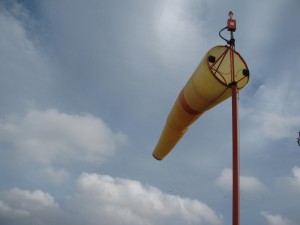Standing on the edge of Midway’s runway, looking east, there is a sea of Laysan Albatrosses that stretches out as far as you can see.

They remind me of people at a summertime concert or the crowd at a popular beach. Some sit quietly, some cuddle, some court, and some cruise about (slowly and awkwardly) looking for trouble. Collectively their chorus is incredible; it is like being at a circus or busy barnyard. They whiny like horses. They moo like cows. They drum like woodpeckers (though not on wood, of course). They even buzz like cell phones. The cacophony is entertaining and endless. Even at night, over the whir of the ceiling fan in my room, I can hear them chattering away in the darkness.
In all, there are 428,090 pairs (and another zillion(ish) unpaired sub-adults) on the island right now. Cumulatively, they represent 70% of the world’s Laysan Albatross population. And I suspect they are the largest acapella group in the world.
Laysans, however, are not the only birds on the island. The U.S Fish & Wildlife Service has recorded 158 species here (mostly passing migrants). Our list, of course, isn’t nearly as long, but it’s pretty amazing – whether you’re a birder or not. We’ve seen 18 species on Midway so far and 38 overall (see below for the complete list). Many of the birds we’ve seen are rare, quite difficult to see (because they spend their lives at sea), or have interesting stories about how and/or why they got here.

From a birders perspective, the Bristle-thighed Curlew and Laysan Duck are probably our two ‘best’ birds on the list. Both are extremely rare. In appearance, however, they are rather pedestrian. The common canary is arguably the most colorful bird on the island. They are dandelion yellow and they stand out against the blue sky, grey asphalt, and dull buildings. The canaries, however, are not native to Midway or the Northwest Hawaiian Islands in general. Canaries, as the name would suggest are from the Canary Islands (and perhaps a few other places). In 1911 they were brought to the island as pets and then released into the wild.
Seeing the canaries flit about is a little surreal. Though I’ve enjoyed seeing them, they seem out of place. They are like the marine debris we’ve been collecting – not from here, but now part of the landscape. They are a powerful reminder of the influence we, as people, have had on our world. Midway, though far from everything, is far from wild. We have left our mark, and our birds.
Midway Birds
1) Laysan Albatross
2) Black Footed Albatross
3) Greater Frigatebird
4) Bonin Petrel
5) Red-tailed tropicbird
6) Cattle Egret
7) Laysan Duck
8) Ruddy Turnstone
9) Pacific Golden Plover
10) Bristle-thighed Curlew
11) Black Noddy
12) Common Fairy-tern
13) Common Myna
14) Common Canary
15) White-tailed Tropicbird
16) Wandering Tattler
17) Brown Booby
18) Northern Pintail
Additional birds seen on Oahu
black crowned night heron
spotted dove
red-crested cardinal
red-vented bulbul
java sparrow
zebra dove
japanese white-eye
red-footed booby
pacific golden plover
black-necked stilt
white-rumped shama
house finch
house sparrow
common waxbill
hawaiian duck
hawaiian coot
common moorhen
red-whiskered bulbul
rock dove
red-billed leiothrix
erckel’s francolin
chestnut mannikin
